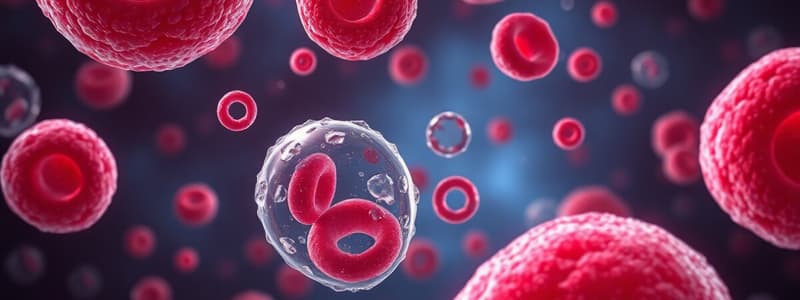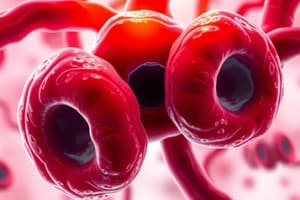Podcast
Questions and Answers
What does the abbreviation 'WNL' signify in the context of RBC morphology evaluation?
What does the abbreviation 'WNL' signify in the context of RBC morphology evaluation?
- Warning Normal Levels
- Within Normal Limits (correct)
- With Nitrogen Levels
- With Neutrophil Levels
Which grading category indicates the least severity for the presence of macrocytes?
Which grading category indicates the least severity for the presence of macrocytes?
- 3+
- WNL (correct)
- 1+
- 2+
For teardrop poikilocytes, what is the threshold for a grading of 3+?
For teardrop poikilocytes, what is the threshold for a grading of 3+?
- 5-10
- 2-5
- 10-20 (correct)
- > 20
What morphological characteristic shows an absence threshold for grading?
What morphological characteristic shows an absence threshold for grading?
Which RBC morphology characteristic is associated with a normal limit grading of 0-2?
Which RBC morphology characteristic is associated with a normal limit grading of 0-2?
What is the grading threshold for '3+' in burr cells?
What is the grading threshold for '3+' in burr cells?
Which of the following RBC characteristics has a grading range that exceeds 20 for 4+?
Which of the following RBC characteristics has a grading range that exceeds 20 for 4+?
How is hypochromia assessed for grading purposes?
How is hypochromia assessed for grading purposes?
Flashcards
RBC Morphology
RBC Morphology
The study of the shape and size of red blood cells (RBCs).
Macrocyte
Macrocyte
A red blood cell larger than normal (greater than 9 μm diameter).
Microcyte
Microcyte
A red blood cell smaller than normal (less than 6 μm diameter).
Hypochromia
Hypochromia
Signup and view all the flashcards
Poikilocytosis
Poikilocytosis
Signup and view all the flashcards
Burr Cells
Burr Cells
Signup and view all the flashcards
Acanthocytes
Acanthocytes
Signup and view all the flashcards
Schistocytes
Schistocytes
Signup and view all the flashcards
Teardrop Poikilocytes (Dacryocytes)
Teardrop Poikilocytes (Dacryocytes)
Signup and view all the flashcards
Target Cells (Codocytes)
Target Cells (Codocytes)
Signup and view all the flashcards
Spherocytes
Spherocytes
Signup and view all the flashcards
Ovalocytes
Ovalocytes
Signup and view all the flashcards
Stomatocytes
Stomatocytes
Signup and view all the flashcards
Sickle Cells (Drepanocytes)
Sickle Cells (Drepanocytes)
Signup and view all the flashcards
Polychromatophilia
Polychromatophilia
Signup and view all the flashcards
Basophilic Stippling
Basophilic Stippling
Signup and view all the flashcards
Howell-Jolly Bodies
Howell-Jolly Bodies
Signup and view all the flashcards
Siderocytes (Pappenheimer Bodies)
Siderocytes (Pappenheimer Bodies)
Signup and view all the flashcards
Study Notes
RBC Morphology Evaluation
- Classification criteria: Grades RBC morphology abnormalities.
- Grading scale: Uses 0-5, 5-10, 10-20, 20-50, and > 50 for occurrence counts per oil immersion field.
- Positive grading: When present, is graded only as positive regardless of instances of abnormalities.
Morphological Characteristics
- Macrocytes: Larger than 9 μm diameter.
- Microcytes: Smaller than 6 μm diameter.
- Hypochromia: Deficiency in the color of RBCs.
- Poikilocytosis: Abnormal variation in the shape of RBCs (generalized variations in shape).
- Burr cells: RBCs with multiple small projections.
- Acanthocytes: RBCs with irregular, thorny projections.
- Schistocytes: Fragmented RBCs.
- Teardrop poikilocytes: RBCs in the shape of a teardrop.
- Target cells (codocytes): RBCs with a central area of increased concentration of hemoglobin.
- Spherocytes: Smaller, spherical RBCs.
- Ovalocytes: Oval-shaped RBCs.
- Stomatocytes: RBCs containing narrow linear central staining.
- Sickle cells (drepanocytes): Crescent-shaped RBCs.
- Polychromatophilia: Presence of bluish-gray, immature RBCs.
- Basophilic stippling: Presence of small blue granules within the RBC.
- Howell-Jolly bodies: Small, dense, round inclusions within RBCs.
- Siderocytes (Pappenheimer bodies): Red granules within the RBC.
Additional Notes
- Quantified by occurrence: Measured by the number of occurrences per oil immersion field.
- Typical field range: Approximately 200 to 250 RBCs in a 100x oil objective field.
- Newborn Considerations: Specific ranges or absence/presence criteria for newborns are noted for certain characteristics.
Studying That Suits You
Use AI to generate personalized quizzes and flashcards to suit your learning preferences.




